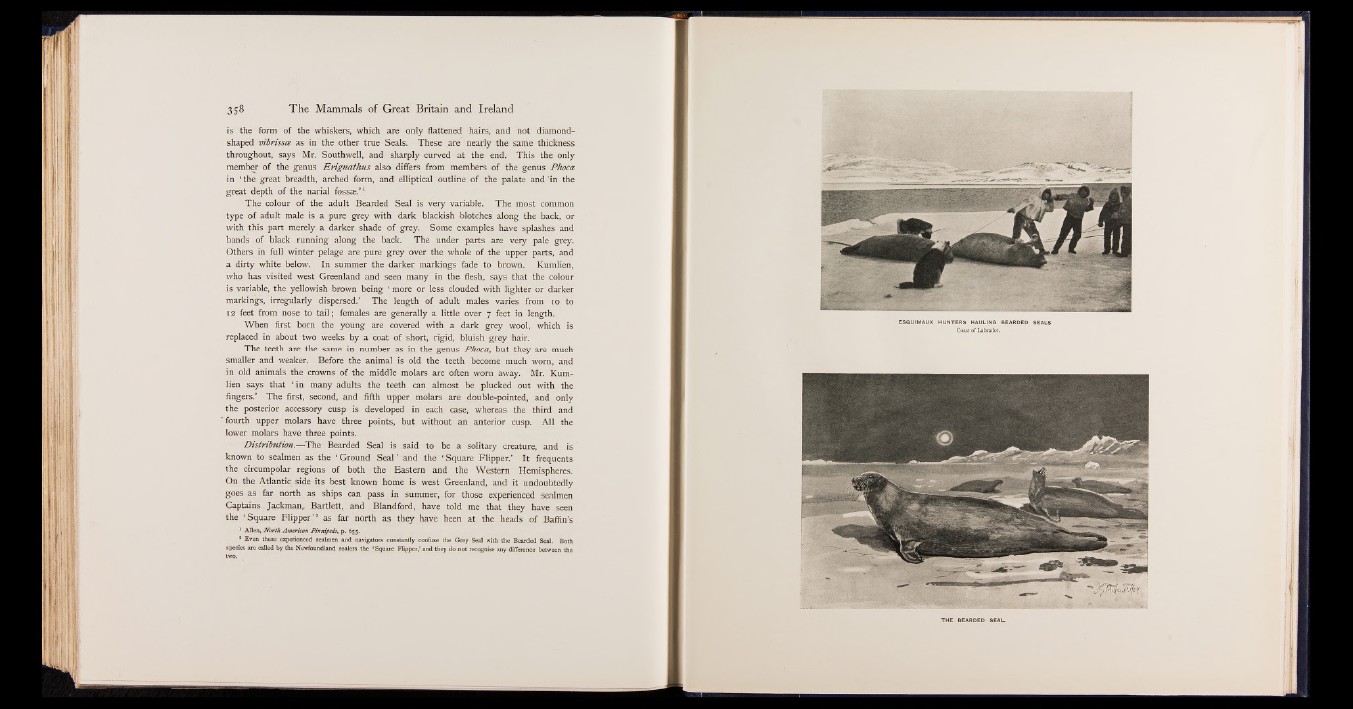
is the form of the whiskers, which are only flattened hairs, and not diamondshaped
vibrissa as in the other true Seals. These are nearly the same thickness
throughout, says Mr. Southwell, and sharply curved at the end. This the only
member of the genus Erignathus also differs from members of the genus Phoca
in ‘ the great breadth, arched form, and elliptical outline of the palate and 'in the
great depth of the narial fossas.’ 1
The colour of the adult Bearded Seal is very variable. The most common
type of adult male is a pure grey with dark blackish blotches along the back, or
with this part merely a darker shade of grey. Some examples have splashes and
bands of black running along the back. The under parts are very pale grey.
Others in full winter pelage are pure grey over the whole of the upper parts, and
a dirty white below. In summer the darker markings fade to brown. Kumlien,
who has visited west Greenland and seen many in the flesh, says that the colour
is variable, the yellowish brown being ‘ more or less clouded with lighter or darker
markings, irregularly dispersed.’ The length of adult males varies from io to
12 feet from nose to tail; females are generally a little over 7 feet in length.
When first born the young are covered with a dark grey wool, which is
replaced in about two weeks by a coat of short, rigid, bluish grey hair.
The teeth are the same in number as in the genus Phoca, but they are much
smaller and weaker. Before the animal is old the teeth become much worn, and
in old animals the crowns of the middle molars are often worn away. Mr. Kumlien
says that ‘ in many adults the teeth can almost be plucked out with the
fingers.’ The first, second, and fifth upper molars are double-pointed, and only
the posterior accessory cusp is developed in each case, whereas the third and
fourth upper molars have three points, but without an anterior cusp. All the
lower molars have three points.
Distribution.— The Bearded Seal is said to be a solitary creature, and is
known to sealmen as the ‘ Ground Seal’ and the ‘ Square Flipper.’ It frequents
the circumpolar regions of both the Eastern and the Western Hemispheres.
On the Atlantic side its best known home is west Greenland, and it undoubtedly
goes as far north as ships can pass in summer, for those experienced sealmen
Captains Jackman, Bartlett, and Blandford, have told me that they have seen
the ‘ Square Flipper’ 2 as far north as they have been at the heads of Baffin’s
1 Allen, 'North American Pinnipeds, p. 655.
* Even these experienced sealmen and navigators constantly confuse the Grey Seal with the Bearded Seal. Both
species are called by the Newfoundland sealers the ‘ Square Flipper,’ and they do not recognise any difference between the